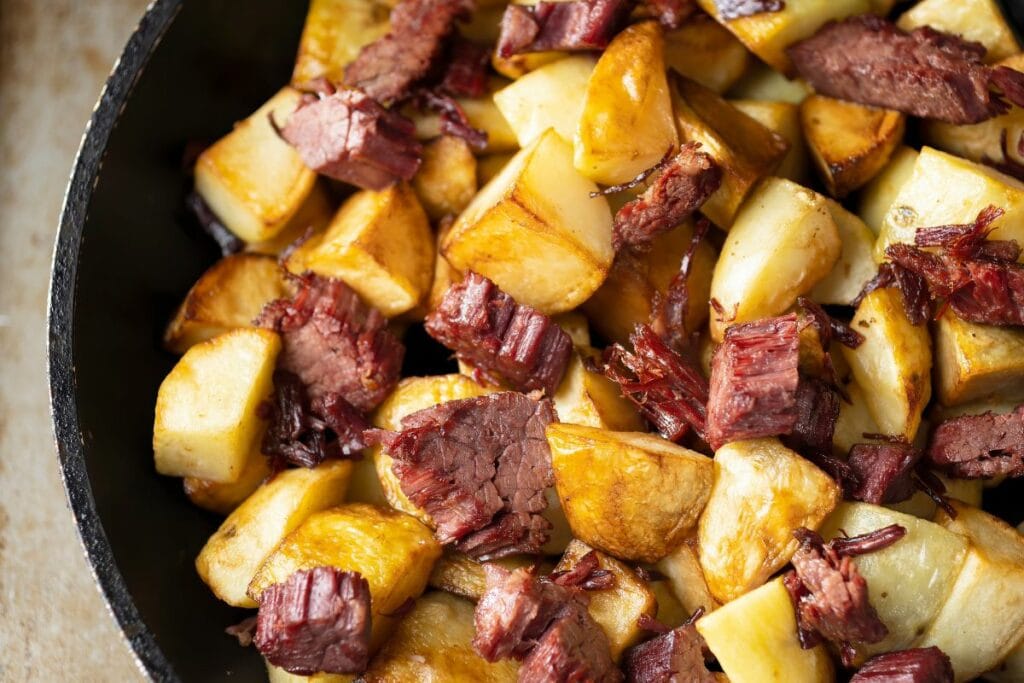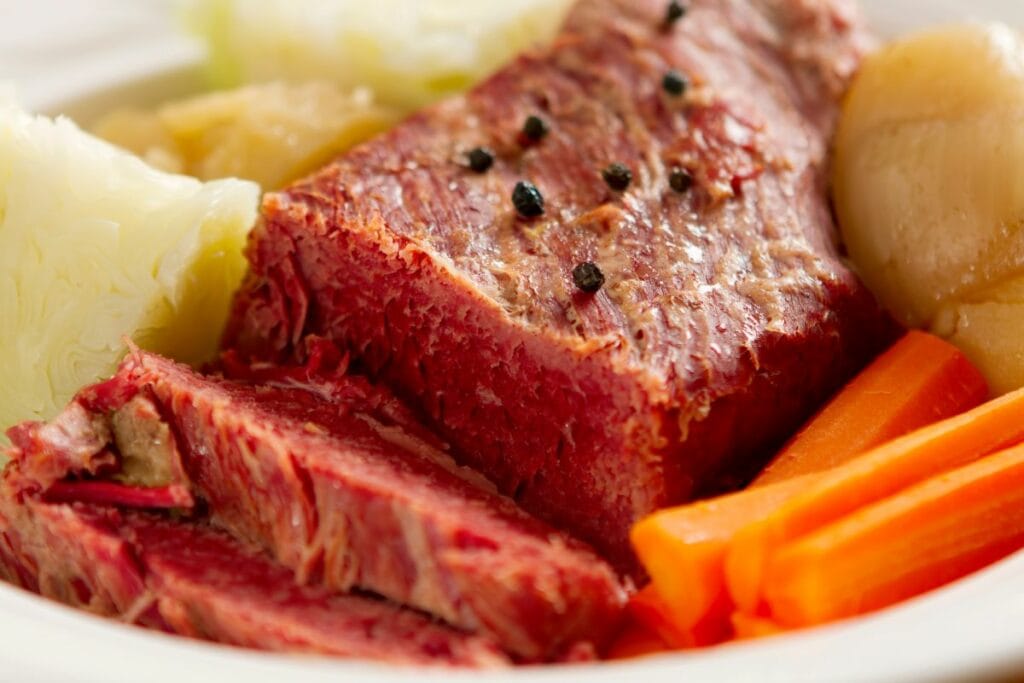This past weekend, my mother-in-law was here, so I made our St. Patrick’s day feast a bit early. I figured it would be fun to serve her the traditional Corned Beef, potatoes, carrots, and cabbage while she was here because she is Irish.
While purchasing the corned beef, I realized I hadn’t done my homework. Point cut and flat cut corned beef are the two available cuts. The point cut is cheaper. Having no idea what to get, I bought both because we needed two, given the number of people we had.
I made the point cut in the crockpot. The seasoning packet was the only addition, and I let it cook all day. About half way through cooking, I added the cabbage. The flat cut was put in a roasting pan with the seasoning packet, water, potato chunks, and carrots. I roasted it at 300 degrees for 6 hours.
Point Cut vs. Flat Cut Brisket Explained
First, the whole brisket is essentially a unique beef cut from the US. A full packer brisket is cut along the point and the flat of two different muscles.
The flat cut is the relatively lean and flat (hence the name flat) portion of beef brisket. The flat cut is later used to create thin slices cut directly across the muscle fibers.
For corned beef, I prefer using points over a flat cut.
Points are a little more forgiving and tender when cooked. They make great corned beef and cabbage.
The flat supports the point, which is separated from it by a layer of fat. The layer of fat and the different fiber courses make it simple to differentiate between the two muscles.
The point cut corned beef is thicker and more marbled than the flat cut version; the higher the quality and the more intramuscular fat a fresh brisket has, the better the outcome.
If of the right quality, a German brisket from the heifer and an Australian full-blood Wagyu brisket are both suitable for the demanding task. But the Wagyu is usually breathtakingly good.
Talk to a good butcher you can trust about your goals and objectives if you have one.
NOT ALL grocery store generic point cuts are actually pointy enough to make corned beef!

What Is Corned Beef?
Simply put, corned beef is a beef cut that has been preserved in a salt brine. Although corned beef has a spicy beef flavor, it also has salty, sour, flavorful, and other qualities. Sometimes, corned beef is ground and cooked.
You can completely cure it, as I’ll demonstrate to you today.
Once the meat has been immersed in the salt solution, it gels. After that, it produces a sliceable shape ideal for your pastrami, for instance.
This beef is served cold or hot. You must have seen some commercial corned beef products available in cans or as cold cuts.
Finally, this beef contains a lot of vitamin B3, essential for various metabolic processes in the body. It also contains riboflavin, niacin, phosphorus, calcium, iron, and magnesium.
What Is the Best Cut of Corned Beef?
Delicious beef with fat and connective tissues, the brisket point cut is ideal for making corned beef.
This portion of the beef brisket has more fat, which may help the corned beef retain moisture. Additionally, I discovered that after brining, the fat from this meat adds a ton of flavor to the corned beef.
Your corned beef needs fat, and the point cut is the only place to get it. Flat cut corned beef will become overly lean and fall short in terms of tenderness and flavor.
This means that you cannot simply use the point cut when brining corned beef. You should also retain some of that thick fat cap. This is what makes the beef delicious and fork-tender.
Additionally, you must take into account that a corned beef flat cut is marginally more expensive because it has less fat and more lean meats.
The point cut corned beef is typically less expensive than the corned beef flat cut, which is one of the reasons corned beef gained popularity.
Corned beef was one of the most consumed meat during the world wars due to its storability, availability, and low price.
Related Reading
Making the Corned Beef
It’s time to brine a nice piece of corned beef after the first week of March so you can enjoy it on March 17 for Saint Patrick’s Day.
The corned beef is prepared for cooking after fermenting for a few weeks in a brine flavored with herbs and spices.
I prefer to let the meat rest in the salting bucket all winter. After that, when spring arrives, the vegetable gardens can start to grow cabbage.
On March 17, Saint Patrick’s Day, it is customary to eat a corned beef dish with new cabbage.
It’s a festive dish that’s grown even more popular among Americans in recent years.
Enough stories, here’s the recipe for your St. Patrick’s Day corned beef.

How to Brine Point Cut Corned Beef?
First, we will be brining the corned beef. Please note, we’re using a point cut of beef brisket.
Your corned beef needs to be brined in salt for a maximum of 10 days for fermentation. Some of my coworkers have shown me how to do it for 5 to 7 days. I suggest brining your corned beef for a maximum of 10 days.
- A container of suitable size for the piece of meat
- A plate smaller than the container
- A weight (for example, 1 jar filled with water)
- Trussing needle
- 4 to 6 pounds of beef
- 34 oz or 1 liter of water
- 200g coarse sea salt
- 50g sugar
- 2 tbsp paprika
- 1 tbsp of each: dried thyme, allspice, crushed mustard seeds, and black pepper.
- 4-5 crushed cloves
- 1 clove of garlic passed through a garlic press
- 3 dried bay leaves, crumbled
Step 1: Rinse and Clean Your Neat
Start by rinsing and drying your piece of meat. On your point, trimming the fat is not necessary. You can remove some of the fat and leave some if there is too much.
Step 2: Poke Holes in the Beef With Some Needle
Then use a trussing needle to repeatedly pricke it from side to side. If you don’t have a trussing needle, you can use a metal skewer instead.
Step 3: Place in a Container
Put it in a container you have chosen for salting.
Step 4: Boil Water and Prepare the Brine
Boil water, add your spices and salt, and let cool.
Step 5: Pour the Brine Over the Meat
Then, add this icy brine to the container with the meat. It must be covered entirely.
Step 6: Hold Down the Meat in the Brine With a Weight
Top with a board or plate that is smaller than the container. Then place the weight. This guarantees that the meat is thoroughly submerged in the liquid and cannot float.
Step 7: Let It Brine
Let the meat brine for 10 days. The first one I made was eaten after seven days. The second guest stayed for 10 days and significantly outperformed the first.
Step 8: Keep Checking It
Check occasionally to make sure the meat is perfectly submerged in the brine, and add more if necessary. In any case, make sure the solution is consistently around 20% salt.
Step 9: Prepare For Cooking
Before or after the 10th day, remove the meat from the brine. Then rinse it thoroughly under cool water.
Depending on how long you brined the meat for, desalt it in fresh water for six hours to overnight.
Step 10: Cook the Meat in a Slow Cooker
There are many ways to cook corned beef. First, you can simmer the meat in the broth for three hours on a low heat. In a casserole or slow cooker, I also like to simmer it for the same amount of time.
Additionally, if you have the necessary tools, you can smoke it to make pastrami.

Corned beef is tender, meaty, and flavorful. That is if you choose the proper brisket cut, which is the key.
The corned beef with the most marbling, fat cap, and connective tissue is the best. They brine better, cook tender, and taste flavorful!.
To allow all the salt and spices to permeate as the meat softens, beef is brined to make corned beef. This helps to slow the spoilage of the meat.
You’ll notice that the meat in a flat cut corned beef will become lean and won’t lose enough fat during cooking. You might not want to prevent the spices from entering, so don’t aim for that.
Note that the advice is applicable in all situations, not just when making homemade corned beef. Apply this principle the next time you go shopping for corned beef.
The Difference Between Flat Cut And Point Cut Corned Beef
FAQ
What is the most tender cut of corned beef?
Which Corned Beef Cut Is More Tender? Point cut is the best cut of corned beef if you want a more tender and juicy meat. It is more flavorful, soft, and juicy than flat cut because it has more marbling and fat.
Which is better corned beef flat cut or tip cut?
The flat cut is leaner. Because corned beef is produced at the brisket point, it is less expensive and has more fat, which keeps the cooked brisket meat moist. 2. Due to the higher fat content, the point cut’s beefy flavor is more potent than the flat cut’s, but it also has less meat and is more difficult to cook.
What is the secret to tender corned beef?
After you have finished cooking the corned beef, always cut the meat against the grain. If you slice against the grain, the result will be more stringy and tough to chew on than if you do the opposite.
What is the best type of corned beef to cook?
Types of Cuts of Corned Beef. The brisket cut of beef, which is thought to be the best cut for making your dish, is used to make the traditional dish of corned beef. A tough and flavorful cut of beef from the lower chest or breast of the cow, brisket. Being heavily worked out gives it a lot of flavor but also makes it tough.
